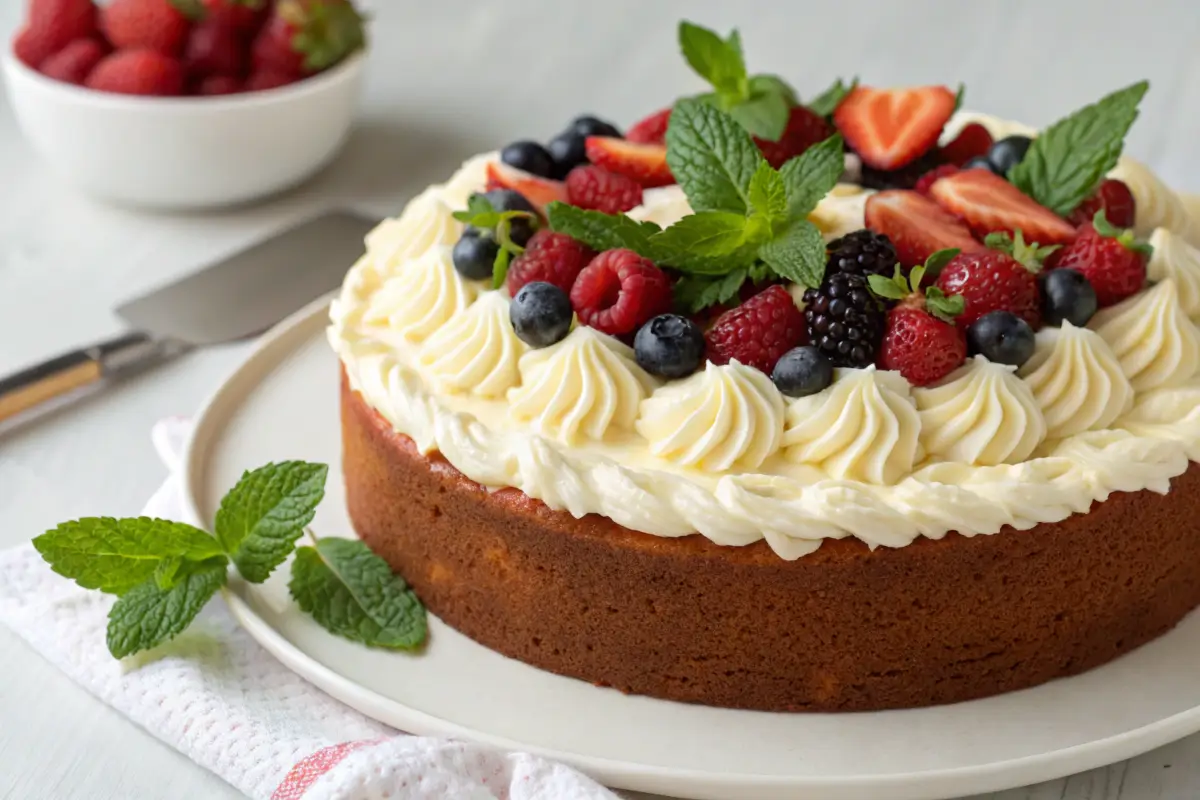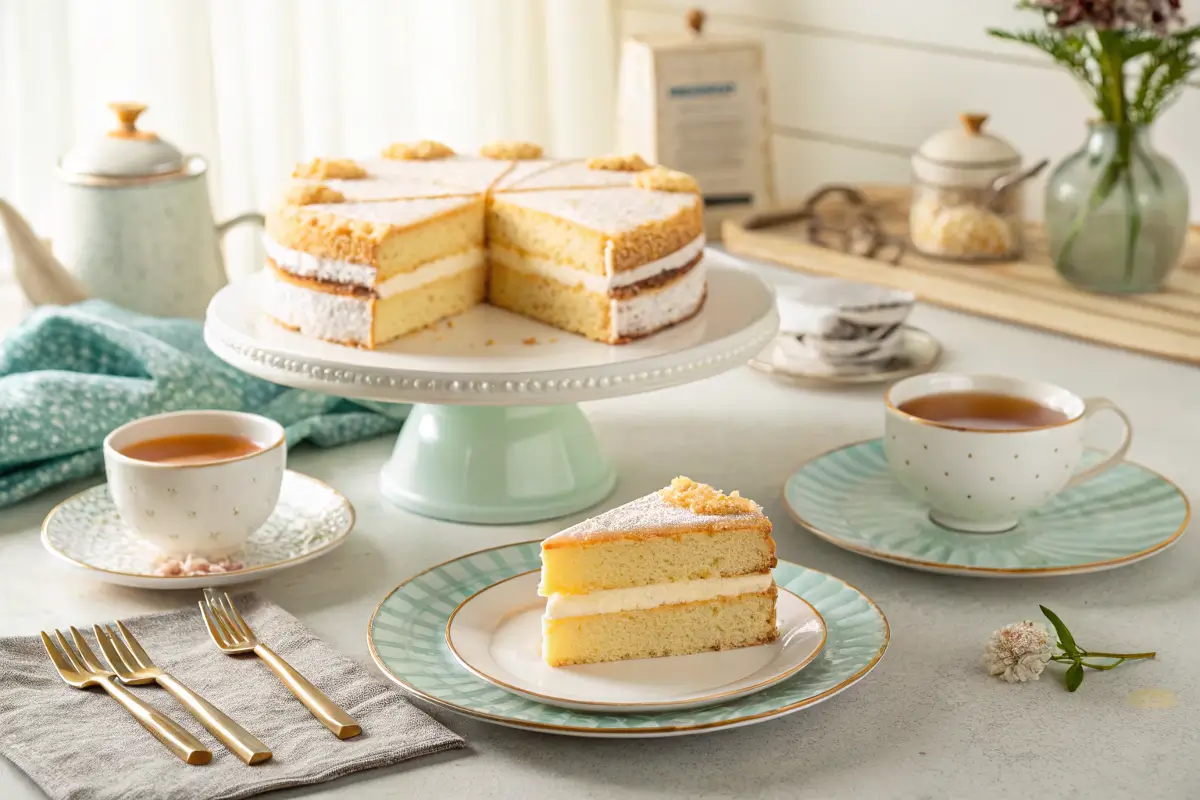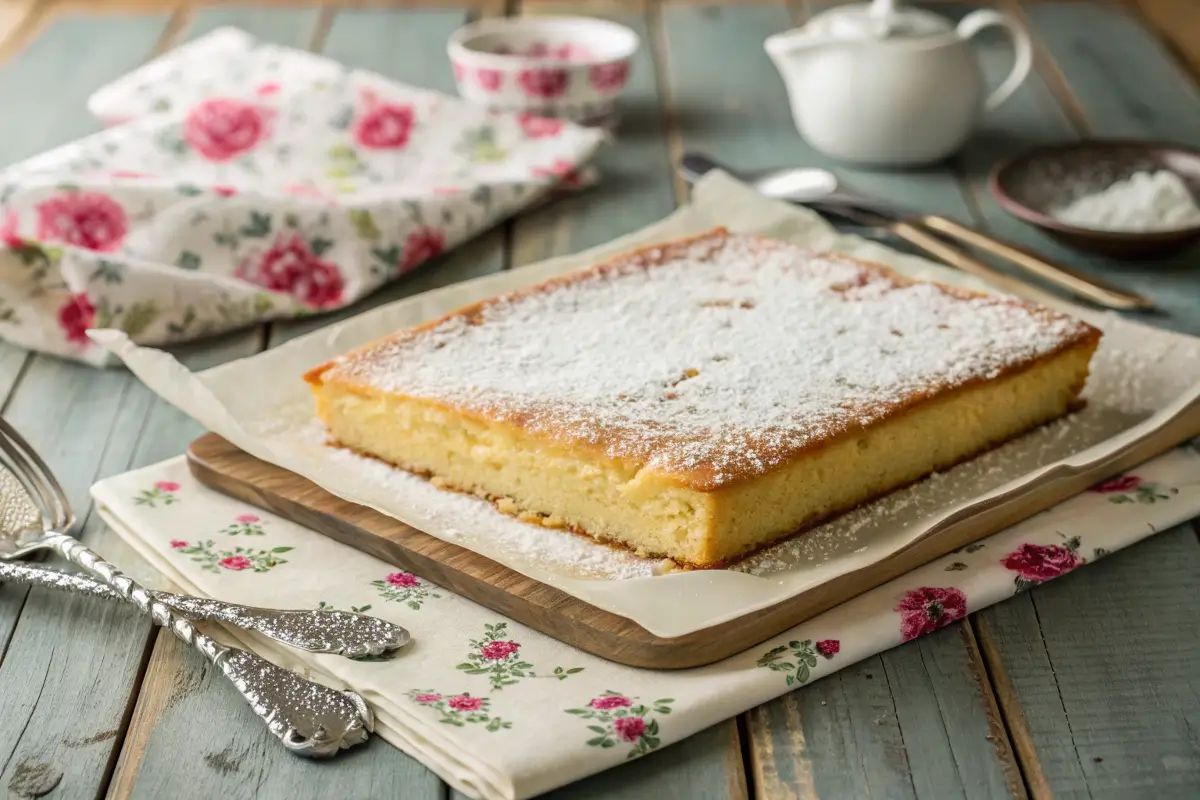When it comes to desserts that blend simplicity, flavor, and health benefits, the kefir sheet cake recipe tops the list. This article is your ultimate guide to mastering this delicious and tangy treat. From understanding the magic of kefir in baking to learning step-by-step techniques, we’ll cover it all. You’ll also discover creative decoration ideas, storage tips, and even troubleshooting tricks to perfect your baking game. By the end, you’ll not only know how to bake a kefir sheet cake but also why it’s a dessert worth making.
Introduction to Kefir Sheet Cake
What Is a Kefir Sheet Cake Recipe?
A kefir sheet cake is more than just another dessert—it’s a moist, fluffy cake infused with the tangy goodness of kefir. Kefir, a fermented dairy product rich in probiotics, brings a unique twist to traditional baking. It adds a slight tartness that balances sweetness while improving the cake’s texture. Perfect for casual gatherings or family dinners, this sheet cake is both comforting and surprisingly easy to make.
Why a Kefir Sheet Cake Is Perfect for Baking
Kefir isn’t just trendy—it’s functional. Its acidity interacts beautifully with baking soda, creating a light and airy texture. Plus, kefir’s natural creaminess keeps the cake moist for days. Unlike regular milk, kefir’s fermented properties give it a depth of flavor that elevates your baked goods. Think of it as the secret ingredient that turns a basic sheet cake into a culinary masterpiece.
Overview of This Easy Kefir Cake Recipe
The kefir sheet cake recipe is straightforward enough for beginners yet versatile for seasoned bakers to get creative. Whether you want to keep it classic or experiment with flavor twists like lemon or chocolate, this recipe has you covered. Aside from being delicious, it’s packed with probiotics, making it a dessert you can feel good about enjoying.
Ingredients and Tools Needed
Key Ingredients for the Perfect Kefir Sheet Cake Recipe
To create the perfect kefir sheet cake recipe, you need a simple list of ingredients that work together harmoniously. Here’s what you’ll need:
- All-purpose flour (2 cups): Provides the structure for the cake.
- Kefir (1 cup): Adds a tangy flavor and keeps the cake moist.
- Granulated sugar (1 cup): Sweetens the cake while balancing the tartness of kefir.
- Baking soda (1 tsp): Reacts with the acidity in kefir to help the cake rise.
- Large eggs (2): Binds the ingredients and adds richness.
- Unsalted butter (½ cup): Offers a soft texture and a buttery taste.
- Vanilla extract (1 tsp): Enhances the cake’s flavor profile.
These ingredients combine to deliver a moist, tangy cake that’s not overly sweet—ideal for any occasion.
Substitutes for Kefir in Cake Recipes
You can experiment with this recipe by using alternative ingredients:
- Whole wheat flour: For a healthier option.
- Greek yogurt: A kefir substitute if unavailable.
- Honey or maple syrup: As natural sweetener alternatives.
Each variation offers a unique twist while preserving the essence of the kefir sheet cake recipe.
Essential Baking Tools for a Moist Kefir Cake
The right tools can make or break your baking experience. Ensure you have:
- A 9×13-inch baking pan for the sheet cake.
- Mixing bowls to separate wet and dry ingredients.
- A whisk, spatula, and measuring tools for precise mixing and portioning.
- A wire rack to cool the cake evenly.
Investing in quality tools ensures consistent results and a stress-free baking process.
The Science Behind Kefir in Baking
How Kefir Enhances a Sheet Cake Recipe
Kefir is a fermented dairy product that works wonders in baking. Its acidity creates a light and airy cake by reacting with the baking soda, producing carbon dioxide bubbles. These bubbles expand during baking, giving the cake its soft, fluffy texture.
Moreover, kefir’s tangy flavor balances the sweetness in the recipe, adding depth and complexity. It’s this blend of science and flavor that makes the kefir sheet cake recipe stand out.
Kefir’s Reaction with Baking Soda
One of kefir’s superpowers is its ability to interact with baking soda. The lactic acid in kefir neutralizes the soda, triggering a chemical reaction that releases carbon dioxide. This process:
- Prevents dense textures by aerating the batter.
- Promotes even rising for a consistent crumb structure.
It’s a simple but vital step that elevates your cake from good to great.
Nutritional Benefits of Using Kefir in Desserts
Aside from its baking properties, kefir offers health perks:
- Probiotics: Support gut health and digestion.
- Calcium and protein: Essential for strong bones and muscles.
- Lower sugar content: Compared to other dairy options, making it a healthier choice.
By incorporating kefir into desserts, you’re crafting a treat that’s as wholesome as it is delicious.
Incorporating kefir isn’t just about achieving the perfect cake texture—it’s about embracing a healthier approach to baking. Next, we’ll guide you through the step-by-step process to bring this science to life.
Step-by-Step Recipe Guide
Preparation Steps for a Perfect Kefir Sheet Cake Recipe
Creating the perfect kefir sheet cake recipe begins with proper preparation. Start by preheating your oven to 350°F (175°C)—this ensures even baking. Grease a 9×13-inch baking pan lightly with butter or line it with parchment paper to prevent sticking.
Next, gather all your ingredients and ensure they’re at room temperature. This helps them blend seamlessly, leading to a smooth batter and a fluffier cake.
How to Mix Wet and Dry Ingredients for the Best Texture
- Dry Ingredients: In a large mixing bowl, sift together the all-purpose flour, baking soda, and a pinch of salt. Sifting prevents lumps and ensures even distribution of leavening agents.
- Wet Ingredients: In another bowl, whisk the kefir, melted butter, eggs, sugar, and vanilla extract until smooth. The tangy kefir not only enhances flavor but also keeps the cake moist.
Combining, Pouring, and Baking
- Gradually fold the wet mixture into the dry ingredients. Use a spatula to gently mix until just combined—overmixing can result in a dense cake.
- Pour the batter into the prepared baking pan, spreading it evenly. Tap the pan lightly on the counter to remove air bubbles.
- Bake in the preheated oven for 25-30 minutes, or until a toothpick inserted in the center comes out clean. The cake should have a golden-brown top and a light, spongy texture.
Baking and Cooling Tips for Your Kefir Cake
Once baked, allow the cake to cool in the pan for about 10 minutes. Then, transfer it to a wire rack to cool completely. This step prevents overcooking and helps maintain the cake’s moisture. Now, your kefir sheet cake recipe is ready for decorating or serving as is!
Decorating and Flavor Variations

Classic Frosting Options
The versatility of the kefir sheet cake recipe allows you to get creative with toppings. Classic options include:
- Cream Cheese Frosting: A smooth, tangy layer that complements the kefir’s tartness.
- Chocolate Ganache: Adds a rich, decadent finish for chocolate lovers.
- Powdered Sugar Dusting: Simple yet elegant, perfect for a lighter option.
For an extra touch, sprinkle toasted nuts or shredded coconut over your chosen frosting.
Incorporating Fruits, Nuts, and Spices
Enhance your cake with natural flavors:
- Fresh Berries: Add a refreshing, juicy contrast to the cake’s tanginess.
- Citrus Zest: Lemon or orange zest in the batter or frosting can brighten the flavors.
- Warm Spices: A hint of cinnamon or nutmeg adds depth, especially during cooler months.
These simple additions elevate the cake’s appearance and flavor profile, making it a showstopper.
Adapting Recipes for Different Flavors
If you’re feeling adventurous, adapt the base kefir sheet cake recipe into something unique:
- Lemon Kefir Cake: Add lemon juice and zest for a zesty twist.
- Chocolate Kefir Cake: Mix cocoa powder into the batter for a rich, chocolaty dessert.
- Vegan Kefir Cake: Substitute kefir with plant-based kefir and eggs with a flaxseed mixture.
These variations let you customize the cake for dietary preferences or special occasions.
For more creative dessert ideas, check out our guide to baking with almond flour. It’s packed with tips for experimenting in the kitchen!
Storage and Serving Tips

Storing at Room Temperature
An unfrosted kefir sheet cake recipe is best stored at room temperature if you plan to enjoy it within two days. Place the cake in an airtight container or wrap it tightly in plastic wrap to prevent it from drying out. The tangy kefir helps the cake retain moisture, so it stays soft and flavorful.
If your cake is frosted, store it in a cool, dry place for up to one day, ensuring it’s covered to maintain its texture.
Refrigeration Guidelines for Frosted Cakes
When your cake features creamy frostings like cream cheese or ganache, refrigeration is a must. Transfer the cake to a sealed container and refrigerate it for up to one week. To serve, bring the cake to room temperature—this allows the flavors to fully develop and the frosting to soften for the best taste.
Freezing Instructions for Long-Term Storage
For long-term storage, slice the cake into portions and wrap each slice individually in plastic wrap. Then, place the slices in a freezer-safe bag or container. This method locks in freshness for up to three months. To thaw, leave the slices in the refrigerator overnight or at room temperature for a few hours.
By following these storage tips, you’ll enjoy the kefir sheet cake recipe at its freshest, whether you’re serving it immediately or saving it for later.
Common Baking Issues and Troubleshooting
Preventing Dense Cakes
A dense kefir sheet cake recipe often results from overmixing the batter. When you overmix, the gluten in the flour develops excessively, leading to a tougher texture. To avoid this, fold the wet and dry ingredients gently until just combined. Also, measure your ingredients accurately—too much flour can weigh the batter down.
Tips for Even Baking
Uneven baking is a common challenge, but it’s easy to fix with a few adjustments:
- Preheat the oven thoroughly: Ensure the temperature is consistent before placing the cake inside.
- Use the center rack: This position promotes even heat distribution.
- Rotate the pan: Turn the cake halfway through baking to prevent one side from overcooking.
These small changes can make a big difference in your cake’s texture and appearance.
Avoiding Dry or Sunken Cakes
Dry cakes are often a result of overbaking. Set a timer and check for doneness a few minutes before the suggested baking time ends. A toothpick inserted into the center should come out clean or with a few moist crumbs.
If your cake sinks in the middle, the issue might be old baking soda or opening the oven door too frequently. Always use fresh ingredients and avoid disrupting the baking process.
With these troubleshooting tips, your kefir sheet cake recipe will turn out perfectly every time!
FAQs on Kefir Sheet Cakes
Can I Replace Milk with Kefir in Baking?
Absolutely! Kefir works wonderfully as a substitute for milk in most baking recipes, including the kefir sheet cake recipe. Its acidity enhances the rise and texture of baked goods, resulting in a soft and fluffy crumb. If you’re out of milk or looking for a tangy twist, kefir is a great option.
What Makes Kefir Unique Compared to Yogurt?
While both kefir and yogurt are fermented dairy products, kefir has a thinner consistency and a more pronounced tang. Its higher probiotic content and active cultures make it a healthier alternative in baking. The kefir sheet cake recipe benefits from these properties, as the probiotics add depth of flavor and improve the cake’s overall texture.
How Long Does Kefir Last Once Opened?
After opening, kefir typically stays fresh for 1–2 weeks when refrigerated. To ensure it’s safe to use, check for any unusual smell or texture. Using fresh kefir is crucial for recipes like the kefir sheet cake recipe, as its acidity plays a vital role in the baking process.
Is Kefir Suitable for Gluten-Free Baking?
Yes, kefir can be used in gluten-free baking! Pair it with a gluten-free flour blend and a binding agent like xanthan gum to maintain the cake’s structure and softness. The kefir sheet cake recipe can easily be adapted for those with gluten sensitivities without sacrificing flavor.
By answering these common questions, you’re equipped with the knowledge to make the most of kefir in your baking adventures.
Conclusion and Final Thoughts
The kefir sheet cake recipe is a delightful fusion of tangy flavor and tender texture. Whether you’re an experienced baker or a beginner, this recipe offers simplicity and versatility, making it a go-to for any occasion. The magic of kefir lies in its ability to enhance not only the taste but also the nutritional profile of your baked goods.
From classic cream cheese frosting to creative flavor variations like chocolate or lemon, this cake is a blank canvas for your culinary imagination. And with proper storage, you can enjoy its moistness and tangy goodness for days to come.
Moreover, troubleshooting tips and ingredient flexibility ensure your baking experience is smooth and rewarding. So, whether you’re substituting kefir for milk or experimenting with gluten-free options, this recipe adapts beautifully to your needs.
Incorporating kefir into your desserts opens up a world of flavor and health benefits. Why not try this kefir sheet cake recipe today? It’s sure to become a staple in your baking repertoire, offering a balance of sweetness and tang that’s hard to resist. Happy baking!

